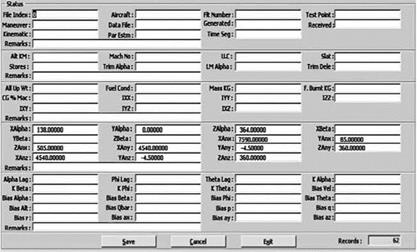Transactions
The signals obtained from the flight maneuvers in ASCII file format can be stored in the data storage device. The FDBM application helps to upload raw or processed data from the storage device and subsystems. The file index-flight number will be the key ID to identify the respective flight/S&C data/parameters. The user interfaces available are status, bounds on the data, bounds on the longitudinal estimation, longitudinal reference values bounds, lateral estimation bounds, lateral reference values bounds, upload files, and delete transactions.
7.9.5.1 Graphs/Reports
Graphs could be plotted with respect to the available flight data to view the acquired/stored signal status. This helps the user decide the scope of values and the type of graph to print. For printing the reports the user can select multiple columns from multiple tables. The user interfaces available under this menu are plot graphs, raw data graphs, processed data graphs, and derivative graphs. Under the report menu, the print reports option is available.
|
FIGURE 7.14 A typical status screen of the flight database management system SW. 7.9.5.3 User Maintenance |
The system administrator can add/modify the users. Users would be provided the privileges based on their roles. The users would have options to change their passwords. The user interfaces available under this menu are add/modify user and change password.
EPILOGUE
Flight testing of any aircraft is a very important activity from the point of view of performance evaluation and certification. The concept of energy management seems to be very interesting in the understanding of various flight test maneuvers. Before performing these maneuvers on the real aircraft, one can carry out the same on flight simulators. The simulator flight data can be studied and analyzed to gain confidence in performing these maneuvers in real flight. Flight database management is of extreme importance due to the vast amount of flight trajectories that could get accumulated. Keeping track of the data and the related information generated via extensive analysis is necessary for successful completion of flight tasks. Only a few aspects of flight testing and DBMS have been covered in this chapter. Flight testing is generally not extensively considered in flight mechanics courses. In addition, open literature in this area is fairly limited.














